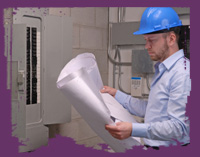Tell Me More Natural Gas Safety-SMART! Home
Natural Gas Careers
Here are some of the many careers in the natural gas industry:
- Photogrammetrists
- Seismologists
- Petroleum Engineers
- Rotary Drillers
- Natural Gas Processing Workers
- Maintenance Workers
- Heating Equipment Technicians
- Natural Gas Appliance Repair Technicians
 Photogrammetrists. These mapping scientists use aerial photos to make drawings of the earth's surface and subsurface. They use Global Positioning System (GPS) technology, which relies on satellites to send radio signals to special instruments on the earth's surface. The instruments, which receive signals from several satellites simultaneously, help photogrammetrists draw the most accurate picture possible. Geophysical prospecting surveyors help photogrammetrists develop maps to help locate natural gas deposits.
Photogrammetrists. These mapping scientists use aerial photos to make drawings of the earth's surface and subsurface. They use Global Positioning System (GPS) technology, which relies on satellites to send radio signals to special instruments on the earth's surface. The instruments, which receive signals from several satellites simultaneously, help photogrammetrists draw the most accurate picture possible. Geophysical prospecting surveyors help photogrammetrists develop maps to help locate natural gas deposits.
Seismologists. These engineers analyze the patterns that result as sound waves are forced deep into the earth. The way the sound waves bounce back reflects rock formations that are likely to hold natural gas.
 Petroleum Engineers. These engineers search the world for reservoirs containing oil or natural gas. Once these are discovered, petroleum engineers work with geologists and other specialists to understand the geologic formation and properties of the rock containing the reservoir, determine the drilling methods to be used, and monitor drilling and production operations. They design equipment and processes to achieve the maximum profitable recovery of oil and natural gas. Petroleum engineers rely heavily on computer models to simulate the effects of various drilling options.
Petroleum Engineers. These engineers search the world for reservoirs containing oil or natural gas. Once these are discovered, petroleum engineers work with geologists and other specialists to understand the geologic formation and properties of the rock containing the reservoir, determine the drilling methods to be used, and monitor drilling and production operations. They design equipment and processes to achieve the maximum profitable recovery of oil and natural gas. Petroleum engineers rely heavily on computer models to simulate the effects of various drilling options.
 Rotary Drillers. Rotary drilling crews usually consist of four or five workers who operate large machinery involved in drilling for natural gas. Rotary drillers supervise the crew and operate machinery that controls drilling speed and pressure. Rotary-driller helpers guide the lower ends of pipe to well openings and connect pipe joints and drill bits. Rotary-rig engine operators are in charge of engines that provide the power for drilling and hoisting. Derrick operators work on small platforms high on rigs to help run pipe in and out of well holes and operate the pumps that circulate mud through the pipe.
Rotary Drillers. Rotary drilling crews usually consist of four or five workers who operate large machinery involved in drilling for natural gas. Rotary drillers supervise the crew and operate machinery that controls drilling speed and pressure. Rotary-driller helpers guide the lower ends of pipe to well openings and connect pipe joints and drill bits. Rotary-rig engine operators are in charge of engines that provide the power for drilling and hoisting. Derrick operators work on small platforms high on rigs to help run pipe in and out of well holes and operate the pumps that circulate mud through the pipe.
Natural Gas Processing Workers. Most workers involved in natural gas processing are equipment operators. Wellhead pumpers operate power pumps and auxiliary equipment to produce the flow of oil or natural gas from wells in oil fields. Gas treaters tend automatically controlled treating units that remove water and other impurities from natural gas. Gas compressor and gas pumping station operators operate steam, gas, electric motor, or internal combustion engine driven compressors. They transmit, compress, or recover gases, such as butane, nitrogen, hydrogen, and natural gas. Gas plant operators operate gas liquefying equipment, operate compressors to control gas pressure in transmission pipelines, and coordinate injections and withdrawals at storage fields.
 Maintenance Workers. Many employees in large natural gas processing plants—welders, electricians, instrument repairers, and laborers, for example—perform maintenance activities. In contrast, many small plants are automated and are checked at periodic intervals by maintenance workers or operators, or monitored by instruments that alert operators if trouble develops. In non-automated plants, workers usually combine the skills of both operators and maintenance workers. Gas service dispatchers monitor natural gas lines and send out service trucks and crews to take care of emergencies.
Maintenance Workers. Many employees in large natural gas processing plants—welders, electricians, instrument repairers, and laborers, for example—perform maintenance activities. In contrast, many small plants are automated and are checked at periodic intervals by maintenance workers or operators, or monitored by instruments that alert operators if trouble develops. In non-automated plants, workers usually combine the skills of both operators and maintenance workers. Gas service dispatchers monitor natural gas lines and send out service trucks and crews to take care of emergencies.
Heating Equipment Technicians. These workers follow blueprints or other specifications to install heating systems. After putting the equipment in place, they install fuel and water supply lines, air ducts and vents, pumps, and other components. They may connect electrical wiring and controls and check the unit for proper operation. To ensure the proper functioning of the system, furnace installers often use combustion test equipment such as carbon dioxide, carbon monoxide, and oxygen testers. After a furnace has been installed, heating equipment technicians often perform routine maintenance and repair work to keep the system operating efficiently.
Natural Gas Appliance Repair Technicians. These technicians visually inspect appliances and check for unusual noises, excessive vibration, fluid leaks, or loose parts to determine why they fail to operate properly. They use service manuals, troubleshooting guides, and experience to diagnose particularly difficult problems. They disassemble the appliance to examine its internal parts for signs of wear or corrosion. Repairers follow wiring diagrams and use testing devices to check electrical systems for shorts and faulty connections. After identifying problems, they replace or repair defective belts, motors, heating elements, switches, gears, or other items. They tighten, align, clean, and lubricate parts as necessary. Repairers use common hand tools, including screwdrivers, wrenches, files, and pliers, as well as soldering guns and special tools designed for particular appliances. When repairing appliances with electronic parts, they may replace circuit boards or other electronic components.
Much of this information comes from the U.S. Department of Labor Occupational Outlook Handbook, which can be accessed via www.bls.gov/careeroutlook.



